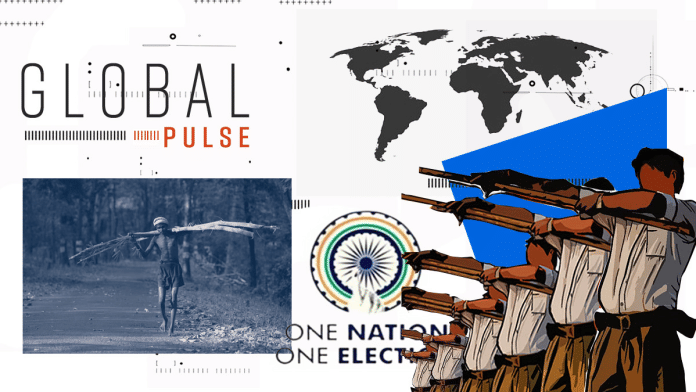New Delhi: Members of the Rashtriya Swayamsevak Sangh (RSS) are both “footsoldiers of Hindu nationalism” and “boy scouts with attitude” according to The Economist, adding that the organisation is where bored young men find purpose.
Reported from a shakha in Nagpur, its headquarters, The Economist’s Christmas Special takes a deep dive into the RSS and how it works. With over 5 million members, the RSS is the biggest volunteer group in the world. While its supporters highlight that it does charity work and teaches “young men discipline”, its detractors call it a “bigoted paramilitary group”, the article headlined ‘Inside the RSS, the world’s most powerful volunteer group’.
“To be close to the RSS is to be close to power,” the article says.
“How did a group that advocates traditional values and modest living amass such influence? Its power lies in something simple and visceral: it gives its members ‘a tremendous sense of self-worth,’ it adds, quoting a former member.
The Economist traces the way the RSS morphed from a cultural organisation to a political one, and slowly accumulated the capital to walk the corridors of power. It details how the RSS has presided over violence and conspiracy theories, but insists its peaceful.
The organisation, it says, is presently trying to course-correct from predecessors who admired European fascists, such as MS Goldwalker who openly admired Adolf Hitler and praised the Nazis’s “race pride”, calling it “good lesson for us in Hindustan to learn and profit by”.
According to the article, “A very public tussle is now under way between the RSS and its most famous disciple”—a reference to Prime Minister Modi. “It is hard to say whether Mr Modi needs the RSS more than it needs him, or vice versa.”
Without Modi, The Economist says, “the RSS might never have realised so much of its majoritarian vision. Some RSS bigwigs may resent the way he hogs the limelight, but the rank-and-file revere him.”
In ‘Decoding India’s ‘One Nation, One Election’ plan’, the BBC explains the proposal for simultaneous elections that is backed by the Bharatiya Janata Party (BJP).
Its supporters “argue this approach would slash campaign costs, ease the strain on administrative resources and streamline governance”, while critics warn “it could erode India’s federal structure, concentrating power in the centre and weakening states’ autonomy,” reports Nikita Yadav.
The biggest argument for simultaneous elections, the BBC explains, is that it would cut the costs of holding elections—especially because India seems to constantly be in the throes of an election cycle at any given point in time. But reducing costs could also backfire.
“With 900 million eligible voters, ensuring enough electronic voting machines, security forces and election officials would require extensive planning and resources,” the report says.
A 2015 parliamentary report by the law and justice department says that if simultaneous elections were held “then a total 92.84bn rupees would be needed to procure new voting and voter-verifiable paper audit trail (VVPAT) machines, which dispenses a slip of paper with the symbol of the party the voter selected. These machines would also need to be replaced every 15 years”.
There are also other challenges. The Constitution would have to be amended to set the change in motion and the BJP now lacks the two-thirds majority it requires in Parliament to make such amendments. Most of the support for simultaneous elections come from BJP allies, while opposition parties call it “undemocratic”, claiming it gives an unfair advantage to national parties over regional parties.
Meanwhile, The Guardian shares a rags-to-riches story in Maharashtra: the village of Panchgaon used its forest to go from poverty to prosperity.
Home to a largely adivasi community, residents of Panchgaon were able to win title deeds to their land under the Forest Rights Act and the Panchayat (Extension to Scheduled Areas) Act, according to the report titled ‘Bamboo bonanza: how a village in India used its forest to go from poverty to prosperity.’
“Pachgaon’s residents pursued their entitlement with dogged persistence, and were granted papers confirming their community forest rights in 2012, winning control of 1,006 hectares (2,486 acres) of forest land – with stunning results. The village’s bamboo business made a profit of 3.7m rupees (£35,000) in the last financial year and a total of 34m rupees in the past decade,” writes Roli Srivastava.
In the past decade, the business has raked in a revenue of nearly 6 million rupees a year. The entire village is involved in it, creating its own jobs to sustain development.
“The villagers of Pachgaon are not number-crunching, business-minded people poring over spreadsheets to track revenue and profits. But they are very clear what the revenue is for: to create jobs in the village, fund raw materials to build homes and to support college education for young villagers.”
(Edited by Sanya Mathur)
Also Read: Chinese media hails ‘6-point consensus’ with India as step towards ‘normal development’ of ties






